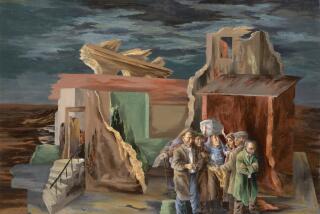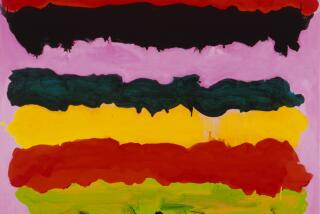Chris Burden’s youthful edge grabbed one TV host by the throat

As a sculptor Chris Burden could be playful -- here he’s posing in 2012 with his “Metropolis II” freeway-scape at the
- Share via
Art turned actionably felonious on the day in 1972 when Chris Burden, invited to a cable television studio in Irvine to create performance art, got up from his chair, pulled a small knife from his belt, and held it to Phyllis Lutjeans’ throat.
It was terrifying while it was happening, Lutjeans recalled Monday, a day after the artist’s death from cancer at 69. But it only added to her admiration of the young Burden as an artist willing to take art beyond the limits.
Lutjeans was then education curator for the Newport Harbor Art Museum in Newport Beach, the predecessor of today’s Orange County Museum of Art. She got to know Burden when he was earning his master’s degree at UC Irvine and would help install exhibitions at the nearby museum.
They became good friends, and as Burden acquired a reputation for edgy work, Lutjeans invited him to do a performance piece on “All About Art,” a program she hosted on a local cable station. She was well aware that weapons were part of Burden’s creative repertoire – when the artist arranged to be shot in the arm with a rifle in 1971 at a studio in Santa Ana, her husband, Alfred Lutjeans, was part of the event, taking pictures to document the piece Burden called “Shoot.”
Lutjeans -- who acknowledges that her recollection of the episode differs somewhat from Burden’s own written account of the knife-wielding piece -- said that before agreeing to create something on camera for her show, the artist had asked her repeatedly over the course of a week to consider whether that was really what she wanted.
“He said, ‘Are you sure, Phyl?’ I said, ‘I really do.’”
Burden showed up for the taping accompanied by photographers. In an era when airliner hijackings were regularly in the news, he hijacked the show.
It was not a setup, Lutjeans said. She recalls having begun to introduce her guest when “he got up very slowly and took out the knife and put it at my neck. I was really terrified, and my thought was, ‘Has he lost it?’”
Burden’s demand as a TV hijacker, Lutjeans said, was for the show to go out live instead of being taped -- or else. What others didn’t hear, she said, was his whispered assurance that she wasn’t really in mortal danger. But the knife remained at her throat.
“They did turn it on live and probably two people saw it on cable TV,” Lutjeans said. “When we walked out, I said, ‘What was that really all about?’ He just said something like, ‘Well, Phyl, I didn’t want our friendship to interfere with the pieces I do.’ That was the kind of work he was doing at that time. That’s why he called me at least twice to say, ‘Are you sure you want me to do a piece?’”
Lutjeans wasn’t about to press charges, but she says some people were shocked that she didn’t hate Burden for what he’d done. Instead, she gave “TV Hijack” credence as a work of art and arrived at an interpretation. For her, Lutjeans said, it became a lesson about her motives for hosting a television show and wanting to push the edge with a guest like Burden. She concluded that ego and pride had something to do with it. Her friendship with Burden went on as before.
Documented in photographs (Burden wrote that he destroyed the studio tape), “TV Hijack” stands as evidence of how hardcore his early work could be. But Lutjeans has a softer view. “The thing people didn’t know about Chris is that he was the sweetest guy.”
Except, perhaps, for a moment in Irvine when that was in serious doubt.
Follow @boehmm for arts news and features
More to Read
The biggest entertainment stories
Get our big stories about Hollywood, film, television, music, arts, culture and more right in your inbox as soon as they publish.
You may occasionally receive promotional content from the Los Angeles Times.










